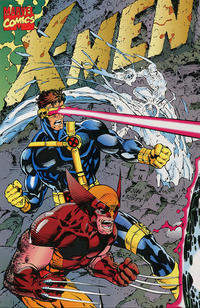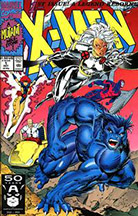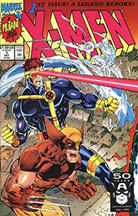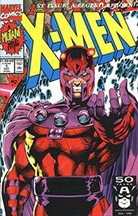The Best-Selling Comic Book of All Time
The record-setting performance of 1991's X-Men Vol. 2, #1,
and how it compares with some international rivals
by John Jackson Miller
 During the heat of the comics boom of the early 1990s, Marvel published the bestselling comic book of all time: X-Men Vol. 2, #1, with sales of 8,186,500 copies.
During the heat of the comics boom of the early 1990s, Marvel published the bestselling comic book of all time: X-Men Vol. 2, #1, with sales of 8,186,500 copies.
Marvel's Uncanny X-Men series was already the bestselling series most months in the North American comic book market at that time, but there had not been a regular North American series called simply X-Men since the series took on the "Uncanny" adjective in 1981. There had never been a regular North American series called simply Spider-Man either until Marvel released one in 1990; the sales of its first issue were so astonishing that it made sense for the publisher to try it again with its bestselling title in 1991. X-Men Vol. 2, #1 was the result — but unlike with Spider-Man #1, Marvel employed a tactic designed to make the issue's release into a month-long event.
 In 1989, DC had launched a new Batman series with a first issue, Batman: Legends of the Dark Knight #1, that had so many preorders that the publisher decided to stagger the shipments across multiple weeks with a different-colored cover on each week's version. It was a tactic intended to provide retailers some novelty to market in case it turned out they over-ordered on the issue; instead, it set off a craze in variant covers that continues, in modified form, to this day.
In 1989, DC had launched a new Batman series with a first issue, Batman: Legends of the Dark Knight #1, that had so many preorders that the publisher decided to stagger the shipments across multiple weeks with a different-colored cover on each week's version. It was a tactic intended to provide retailers some novelty to market in case it turned out they over-ordered on the issue; instead, it set off a craze in variant covers that continues, in modified form, to this day.
With X-Men Vol. 2 #1, Marvel also staggered shipments across multiple weeks — but made each cover a part of a larger image. The fifth version, a double-gatefold cover combining everything into an ad-free issue priced at $3.95, was offered to comics shops only.
It was clear to anyone in the business or fandom that the issue, releasing across August 1991, was bigger than anything yet seen; one retailer reported selling 2,400 copies, or 12 cases, of the 48-page comic book to one customer. The title
topped the charts at the individual distributors — and based on internal Marvel records, Comichron can confirm the individual estimated sales of each cover:
| ISSUE | Direct Market | Newsstand | TOTAL |
|---|---|---|---|
| 1A (Beast) Ship 8/13/91, on sale 8/20/91 | 1,512,000 | 43,000 | 1,555,000 |
| 1B (Colossus) Ship 8/20/91, on sale 8/27/91 | 1,739,500 | 43,000 | 1,782,500 |
| 1C (Cyclops) Ship 8/27/91, on sale 9/3/91 | 1,437,000 | 43,000 | 1,480,000 |
| 1D (Magneto) Ship 9/3/91, on sale 9/10/91 | 1,371,900 | 43,000 | 1,414,900 |
| 1E Collector's Edition Ship 9/10/91, on sale 9/17/91 | 1,954,100 | 0 | 1,954,100 |
| TOTAL #1 | 8,014,500 | 172,000 | 8,186,500 |
The earliest reports of any numbers, from Milton Griepp in Capital City Distribution's August Internal Correspondence magazine, were of "around 7 million copies," but that report acknowledged that there were editions still out for reorders, which the internal data appears to confirm. Within the direct market sales, Capital City's sales of each edition ranged from a high of 424,800 copies, for the Beast cover, to a low of 332,800 copies for the Magneto cover; the Collector's Edition had sales through Capital of 408,300 copies. Capital's overall sales were 1,874,100 copies, or 23.3% of all direct market sales. (There were a dozen different distributors selling to comics shops then). Thanks in part to the issue, Marvel's dollar market share at Capital City in August 1991
was 62.45%, far outpacing DC's 17.95%.
The newsstand draws of the issue in general are far lower than the normal newsstand/direct market breakdowns seen in 1991; it's possible that the newsstand didn't read the same demand for the new title that comics retailers did. The overall newsstand draws are about 60% above what Uncanny X-Men's were at the time; I'm guessing that title was used as an ordering guide. There were also no subscription sales reported, as it was a brand new title.
I reported the internal figures in Comics Buyer's Guide and later on Comichron. In 2010, the Guinness Book of World Records announced it was adding the issue to its 2011 edition; a ceremony was held at the event, with writer Chris Claremont in attendance. Claremont had already been announced as having leaving the title before the issue shipped, ironically; his last work for the series was in the third issue.
There is no American rival to X-Men #1 for this title; there are comic books in the 3-4 million copy range (like X-Force #1, only two months old when the "adjectiveless" X-Men title launched), but there's nothing with numbers like these. Nothing in the Golden Age, legendary claims to the contrary, goes into the high single-digits for millions of copies.
If supply were the only relevant factor, the issue would be one of the least collectible comic books of all time; copies turn up everywhere now, decades later. (I found I had accumulated 25 copies somehow from various collections, and I only bought one in 1991!) MyComicShop.com frequently has the issues for cover price or less. But it is an interesting artifact of a collecting craze at peak frenzy.
If you're looking for a list of bestsellers of all time, take a look at our FAQ on the subject.
International rivals
Not long after the 2011 book's release, I began consulting with a Guinness writer over bestselling international series, as opposed to individual issues — but the question of whether anything outside North America can top X-Men Vol. 2 #1 as the bestselling single comic book is an interesting one. Definitions, here, matter a lot.
For its purposes, Guinness would seem to be defining a comic book as a periodical magazine, as opposed to any other delivery system which contains comics content. That's certainly in line with how the term has always been used in this country: Watchmen #1 is a comic book. Watchmen is a collected edition — and it is also a graphic novel. One is on sale for a month. The other is on sale forever. This is a key distinction, when it comes to making sure we're making apples-to-apples comparisons — and it is important when considering comparisons with international top-sellers such as One Piece and Asterix editions.
 Frequent mention is made in the trade press of the sales records of Eiichiro Oda's manga series One Piece
Frequent mention is made in the trade press of the sales records of Eiichiro Oda's manga series One Piece, which are spectacular indeed: One Piece Vol. 61, sold 3.38 million copies in 2011. All the volumes of the series have sales in the hundreds of millions, in total.
Those sales, however, are for the tankouban, the Japanese equivalent of the American collected edition or graphic novel. Like most American comics that are eventually collected, One Piece appears first in a magazine — although a magazine much different in size from American comic books. One Piece is published serialized in the anthology magazine Shonen Jump, one of several "phone-book magazines" (other examples include Nakayoski, Margaret, and Asuka) collecting chapters of various ongoing works. Bulky and cheaply printed, these magazines tend to be viewed as more disposable, making tankouban more desirable. The Weekly Shonen Jump does sell in the millions of copies, but seems to have peaked in the mid-1990s, with the peak sales for a single issue being 6.53 million copies in 1995.
I would tend to regard the "phone books" as a distinct delivery system from the traditional American comic-book-held-together-by-staples; they are, in many senses, books on their own. There have been American anthology monthlies — indeed, comics began as anthologies — but most topped out at 80 pages, and few have been seen in recent decades. But it is proper to say that Shonen Jump provides a somewhat closer comparison to X-Men Vol. 2, #1 than One Piece does — and there, X-Men #1 holds the edge.
On the other hand, any given One Piece tankouban is more appropriately compared to sales of Watchmen and similar collected editions. Watchmen has sold millions of copies since the graphic novel first appeared in the 1980s, but it's reasonable to speculate that with One Piece's first printings so monumental, there are individual tankouban in those 60 volumes that have outsold it over time.
So One Piece, as a tankouban, stands a good chance to be the international record-holder when it comes to bound-edition bookshelf comics (without undertaking an exhaustive survey of all European and Japanese comics, I can't go farther than that), while X-Men Vol. 2, #1 most likely holds the worldwide title when it comes to periodical newsrack comics with staples.
—Updated Feb. 9, 2017










